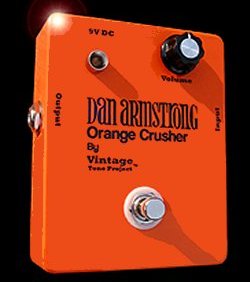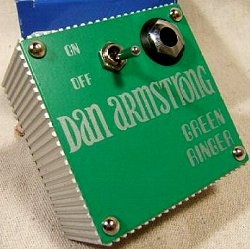

|
Fast forward to 2003 when Dan made enough changes to the original Orange Squeezer thereby allowing him to trademark a
new product called the Orange Crusher. While the Crusher was painstakingly overseen by Dan, they were
built and distributed by a company called the Vintage Tone Project. Unlike his earlier units, the Crusher
is a floor type stomp unit and includes an AC-input jack, volume control, and an indicator light.
In Dan's own words "The Orange Crusher is the Orange Squeezer for the twenty-first century. Ordinary compressors lose
the guitar's attack....the Crusher enhances it. You can play anywhere on the fingerboard and be sure that all notes will
speak right up, and hang in there. Chords have a new strength, power, and definition."
|
As seen upper left, with the bottom cover removed the internal electronics to the unit can be seen. Battery changes
are much easier as a result of more room. At the right, the first 200 units were personally signed by Dan Armstrong
himself. As seen here, my particular unit is number 20 of 200. When I spoke with Dan about my (then) new Crusher - I had already
opened it up to install a battery when I noticed his signature inside. I then scanned it as I planned on using
it in my (then) future update to this site. However, I didn't want to use it without Dan's permission (and more importantly
his blessing). So when I asked if it was OK - Dan replied "Now that's a Capital idea.... I like it..." So.... I did!
Personally, of all Dan's effects units this one is my favorite. It's subtle but I really like it when I play clean. If I play
soft it brings the volume up without introducing a tonal change or distortion. But If I belt a chord a second later,
the volume is naturally brought down to the same as when I strum light. In the past I've tried other similar units but they were too
slow to respond and too obvious. This unit does it instantly and without the obvious 'scouping' sound that the others have. If I didn't
know better I'd swear that this unit knows in advance when I'm going to strum light, or belt out a chord. It's so seamless in the way
that it works - all while maintaining the same tone and sustain which is always lacking in an all clean amp, or amp setting. Think of the
effect as playing through a 'crunch' channel on an amp - with all the sustain & compression thereof, but without any of the 'crunch'.
On July 19th, 2006 - some two years after Dan's passing, Kent Armstrong filed an application with the US Patent &
Trademark Offices to register the trademark name "Dan Armstrong" amongst himself and his four siblings. In my talk with him,
Kent stated "It's really no different than, say....... the family of Elvis getting the rights to his name after his death." Later,
Kent would add that "If one of us kids didn't take the step to register our fathers name, then you leave yourself open to the likely
possibility that the name could be taken from your family as virtually anyone could apply for it and would get the trademark. So in addition
to my own name I also put the trademark name in my brothers and sisters names as well."
Later that year Kent had teamed up with Chuck Wojack, and founded Grafton Electronics. On December 12,
2006 it was announced that Grafton Electronics, under license from Dan Armstrong Enterprises were going to once again
reintroduce the original Dan Armstrong effects units. These units are advertized as being carefully hand-built to
authentic 1975 specifications, and hand built by Chuck Wojack who in his interview with me stated "Since day
one I told everyone that if I were going to be involved with these units that
they would be built in the US and stamped or labeled as such."
Above left and right, 2007 literature for the newly made Dan Armstrong effects units. Larger images are available in the Brochures section.
"The challenge of creating the series all over again and staying true to the original quality and sound that Dan
Armstrong started with was staggering and I can't tell you how many times I had to start over." said
Chuck - who went on to say "The most difficult challenge was finding components that would closely match the
specifications of the original components."
As one who then had full rights to these units Chuck had the drawings, papers and original schematics of the units that Dan
Armstrong and George Merriman made many years prior. He was well aware of the fact that there are various drawings &
schematics of Dan's circuits on the internet and explains "That's the problem with all the schematics on the internet
and everywhere - some are just plain incorrect, and the ones that are correct - reveal components that either are not
available any longer - or if they are - the specs of them have changed over the years and are now different than what
they were back then."
Because of all this, Chuck had to go through a painstaking process and describes "certain minor tweaks were made
to the schematics - usually just the value of a resistor or a capacitor needed to be changed for a component. In most
cases that had to do with certain transistors and integrated circuits that are no longer manufactured. Standard
capacitors, once built from one material has since been replaced by a newer material and thus there are differences in
how the capacitor charges and discharges. Also certain diodes used back then are no longer available - all of this had
to be accounted for when making these effects sound like the original."
This careful attention to detail meant Wojack had to make sure any new components would make the same sound as those
created by the original parts. "We actually put them on an oscilloscope and did some matching with constant frequencies
to see that we got the same type of output as we did from the originals. After the oscilloscope showed the signal to be
identical - it then had a tougher test - and that was Kent Armstrongs ears. He has the originals and knows what they
sound like. I had to get mine to be identical." He closed by stating "This amount of detail takes a lot of
time."
One review of Dan's effects units state that the only thing he could find wrong was that the original units were not
truly bypassed when the effect was turned off, and that some highs were always missing from the original signal as a result.
Chuck then went on to state "As one who has the original schematics I can tell you that this is simply not true. Dan's effects
units were indeed true bypass - the signal went right from the guitar input jack directly over to the output jack if
the unit was off line."
He continues with "If anything, Dan made the mistake of not correcting the extra volume boost on some of his units
because some of them used these little 'op-amps' which greatly boosted the signal when they are engaged. When the unit
is then disengaged, the signal drops back to where it was, and players/reviewers get tricked into thinking the effect
is not off line when in fact - it is."
Chuck finishes with "I've actually had some products returned to us that the dealers said had a problem in this regard
but in reality the 'problem' they speak of is exactly how the original units function. If I were to make them not like
the original, this is one thing I would have corrected - the actual effect would have the same volume level as the
regular signal when the unit is off-line. Actually the Orange Squeezer and Blue Clipper do have volume controls inside
the units and the units instruction papers did, and still do - show how to adjust it."

|
As seen at left, the outside of these effects units are manufactured to the same specs as the original Wareham units
produced back in 1973-74 and even the same die is used to make the aluminum outside boxes that the Wareham units were
made of back then.
Notice the extra locking tabs over the Musitronics units shown earlier. Also notice the raised input jack as well,
all classic features of the Wareham units. In June of 2006 Grafton Electronics announced that the Dan Armstrong
effects units were shipping.
|
continue
menu
Names and images are TMand © Dan Armstrong / Ampeg. All rights reserved.
All other names and images are TMand © of their respective owners. All rights reserved.
|
| |

